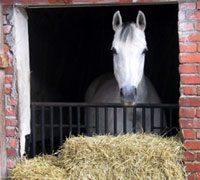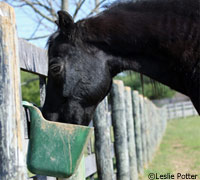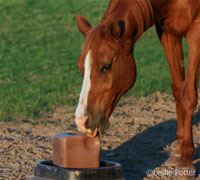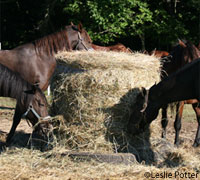A lot of the age-old rules to feed by have been researched and refuted in recent years. It’s important to know where to draw the line between nutrition fact and fiction so you can take the very best care of your horse
1. Fact or fiction?
A flake or two of hay in the morning and at night provides enough roughage.
It depends.
 Many barns feed on this system, including facilities where horses aren’t turned out for grazing time. But is it sufficient to meet a horse’s roughage needs?
Many barns feed on this system, including facilities where horses aren’t turned out for grazing time. But is it sufficient to meet a horse’s roughage needs?
“It depends on the size of the horse, his age, the type and quality of the hay, and what else the horse receives in his diet,” says Warren. “It also depends on the size of the flake, as they can weigh anywhere from 1 to 5 pounds.”
Knowing your horse’s daily requirements is the key. “Ideally, horses should receive 1.5 percent of their body weight (or more) per day as forage or other suitable high-fiber roughage; 1 percent of their body weight would be the bare minimum,” Warren continues.
First, you need to determine your horse’s weight using a weight tape or, ideally, the scale at a large animal vet clinic, as well as the weight of your hay. “I encourage owners to think in fractions of a bale, rather than in flakes,” says Warren. “For example, 2 percent of a 1,200-pound horse’s body weight in timothy hay would be about 24 pounds, or approximately half of a 50-pound bale, per day.”
Feeding sufficient forage keeps your horse occupied throughout the day as nature intended. If a horse isn’t fed enough forage, he may develop stable vices, such as wood-chewing. Additionally, gastric ulcers and digestive disturbances can occur when a horse doesn’t have food moving through his gut regularly all day.
2. Fact or fiction?
Beet pulp must be soaked for hours or it will expand in the stomach, causing it to rupture.
Fiction.
This is one of the more dire nutrition warnings you’ll hear. It seems logical, since beet pulp will expand to many times its original volume when water is added. But science supports the fact that beet pulp can be safely fed without soaking.
“The equine stomach holds 2 to 4 gallons,” explains Warren. “This volume is equivalent to 4.5 to 9.5 pounds of dry beet pulp, which is more than most horses receive in a single meal. Likewise, most food that enters the stomach passes to the small intestine within 15 minutes or less—and if you’ve timed how long it takes beet pulp to expand, it’s longer than 15 minutes.
“Assuming horses have free access to water, they will voluntarily drink enough to process any amount of beet pulp consumed—1.5 to 2 liters per pound of beet pulp,” continues Warren. “Ultimately, the 40 to 50 gallon capacity of the equine digestive tract is more than sufficient enough to contain even a very large meal of beet pulp. If you choose not to soak the beet pulp before feeding it, make sure your horse has access to as much fresh water as he wants, which should be the case no matter what you feed.”
However, there are benefits to soaking beet pulp. Soaking makes it easier to chew, which is especially important when feeding equine seniors that may have missing teeth. It may also increase flavor, which is helpful if you need to add supplements or medication to your horse’s feed. Finally, the extra water will help keep your horse hydrated, which is particularly useful during the winter when the water is too cold to be at its most appealing (at least 45 degrees Fahrenheit for most horses).
Beet pulp should be soaked for three to four hours for maximum benefits, but throw away any leftovers within a day, as it will start to spoil.
3. Fact or fiction?
Oil provides “calm” calories, while grain will make a horse excitable.
True, with a caveat.
 With a barrage of recent research on the benefits of feeding fat as opposed to grain to supplement dietary calories, horse owners may have heard that grain will make their horse more excitable than fat or oil. “As a guiding principle, it’s not that hard and fast,” says Warren. “Generally, what makes a horse excitable is too much digestible energy (calories) in the diet. Horses are unique in that excess calories can make them feel the need to burn them off with greater voluntary activity.”
With a barrage of recent research on the benefits of feeding fat as opposed to grain to supplement dietary calories, horse owners may have heard that grain will make their horse more excitable than fat or oil. “As a guiding principle, it’s not that hard and fast,” says Warren. “Generally, what makes a horse excitable is too much digestible energy (calories) in the diet. Horses are unique in that excess calories can make them feel the need to burn them off with greater voluntary activity.”
But the source of the calories can have an effect on energy levels, too. “Calories from cereal grains are mainly in the form of starch, which is absorbed as glucose,” Warren continues. “This triggers changes in blood sugar and alters hormones such as insulin and thyroid hormone, which can possibly rev up metabolism and excitability.”
Studies have shown that feeding fat calories doesn’t result in the same type of reaction, as blood sugar and hormone levels remain steadier during fat digestion. “If oil is used to help reduce the total starch content of the diet, while keeping the calories the same, we might see a ‘calming’ effect,” Warren explains. But that statement comes with a caveat. “If oil is top-dressed onto the feed and adds calories beyond the horse’s requirement, it could potentially cause excitability from overfeeding dietary energy.”
4. Fact or fiction?
A show horse needs extra protein, especially if he’s exercised a lot.
It depends.
Many show barns encourage feeding more protein to keep up with the demands of a high-performance horse. But is it needed? “Not necessarily,” says Warren. “Exercise does increase the horse’s protein requirement due to increased protein turnover in muscle (building and repairing tissue) and a small amount of protein lost every day in sweat; however, a performance horse’s protein requirements don’t increase to the same magnitude as they do in broodmares or growing horses.”
Increased protein demands in performance horses can be met in most cases by just increasing the calories in the diet; when feeding more hay (or pasture) and grain, this means the horse will also be getting more protein. In addition, attempting to supplement too much protein can be detrimental.
“Some research shows that feeding very high-protein diets can affect acid-base balance of horses during exercise, but the effects are relatively small so the physiological significance is questionable,” says Warren. “However, if a show horse is kept in a stall, all that extra unnecessary protein will be excreted in the urine, causing ammonia buildup that could put the horse at risk for respiratory disease.”
5. Fact or fiction?
You don’t need to put out a salt block if your horse gets commercial grain with vitamins and minerals.
Fiction.
 Many people forget about salt when feeding their horse an otherwise balanced diet. However, sodium is the major electrolyte in body fluids, and it’s critical to nervous system function.
Many people forget about salt when feeding their horse an otherwise balanced diet. However, sodium is the major electrolyte in body fluids, and it’s critical to nervous system function.
“All horses need a source of salt (NaCl) added to their diet,” says Warren. “Salt blocks usually work fine for horses that aren’t undergoing heavy exercise where they sweat a lot. For horses that do sweat, it may be more effective to top-dress the feed with salt. Commercial grain often has 0.5 to 1 percent salt added, but this is usually not enough to meet their daily requirement,” she cautions.
An average-sized horse has a maintenance requirement of about 1 ounce of salt per day, but Warren says a good rule of thumb for a heavily exercised horse is an additional 2 to 3 ounces per hour of heavy sweating.
6. Fact or fiction?
Feeding bran mash, especially after intense exercise, will keep your horse “regular” and prevent colic.
Fiction.
One old adage for keeping horses healthy was to feed mashes made mostly of wheat bran. The original tradition was to feed them to farm horses on Saturday night before their day off on Sunday, or on Monday after taking the weekend off, as a laxative and to prevent colic. But Warren says that this practice doesn’t have the intended effect. “Studies have shown that adding wheat bran to the diet doesn’t have a laxative effect. In fact, the moisture content of the manure was similar whether the horses received wheat bran or not.”
Since doctors tell people to eat bran to promote regularity, many assume this works for horses as well. “In truth, wheat bran is not a high-fiber feed [for horses],” says Warren. “It may have more fiber than corn, but about the same amount as oats—and definitely less than hay.”
So why does bran work for humans and not horses? “The typical equine diet contains more than 35 percent fiber, whereas the typical human diet contains less than 2 percent fiber,” she continues. “A scoop of wheat bran will hardly make a dent in the diet of the horse.”
That said, horses do enjoy the flavor of a bran mash. “Wheat bran should be thought of as grain rather than forage,” says Warren. “However, all brans, including wheat and rice bran, are very high in phosphorus. About 90 percent of the phosphorus in brans is in the form of phytate, which decreases the absorption of calcium, as well as copper, zinc and manganese.” If you feed several pounds of wheat or rice bran to your horse daily, you’ll need to give him supplemental calcium to balance the equation.
If you feed bran mashes just once a week, it could actually cause serious problems. “This can upset the microorganisms in the digestive tract,” says Warren. “Any changes to the diet should be made gradually to avoid colic.” A period of of one to two weeks is usually sufficient to introduce a new feed (of any type) in incrementally increasing quantities to your horse.
7. Fact or fiction?
Alfalfa hay can cause problems and is not a good choice for feeding horses.
Fiction.
Perhaps you’ve heard that feeding straight alfalfa can cause colic, founder, bloat or kidney damage. These feeding myths have no scientific basis.
“Alfalfa hay or cubes are generally a good source of nutrients and fiber for horses,” says Warren. “Alfalfa will generally exceed protein requirements (usually no worry, as the excess will come out in the urine), and may also have to be fed on a limited basis rather than free-choice.”
So unless you have a broodmare or growing youngster, be on the lookout for an alfalfa-fed horse gaining too much weight, and add a lower-calorie grass hay to his diet if possible to help keep him occupied throughout the day.
However, alfalfa isn’t the only rich forage. “Good-quality pasture is often higher in protein and calories than alfalfa hay,” says Warren, so be aware of the same potential for weight gain.
8. Fact or fiction?
Horses shouldn’t be fed round bales of hay, which are only suitable for cattle.
Fiction.
 In some parts of the country, horse farms opt to put out round bales for horses on turnout, particularly in the winter. They are usually cheaper per pound than square bales, and are commonly fed to cattle.
In some parts of the country, horse farms opt to put out round bales for horses on turnout, particularly in the winter. They are usually cheaper per pound than square bales, and are commonly fed to cattle.
“Round bales are just a bigger package than a small square bale,” says Warren. “Depending on storage, however, round bales can contain an outer layer that is more weather- or rain-damaged. This usually causes horses to devour the inside of the bale first, given a choice.”
Warren recommends feeding round bales only if horses can finish them in three to four days. “Any hay that is exposed to the elements after being put out to feed can begin to mold. This would be even more critical if the weather is consistently wet. To prevent excess hay wastage, I also recommend round bales be offered in a round bale feeder that is designed for horses.”
9. Fact or fiction?
If your horse is overweight, the best fix is to cut back his hay and grain. If he is underweight, feed him more hay and grain.
Fiction.
Equine weight management might seem as simple as calories in versus calories out, but there are delicate metabolic factors at play that you also need to be aware of.
“Because cereal grains are rich in starch, they are more calorie-dense than forages,” explains Warren. “So for any horse that is overweight, the first step is to cut back on the high-calorie feeds, such as grain. If that doesn’t work, then perhaps a more mature, lower-calorie hay could be selected to permit the desired ‘chew time’ the horse wants while not overloading on calories.”
To put weight on a horse, try using higher-quality hay that contains more calories, such as an earlier-maturity cutting or grass hay mixed with alfalfa, before upping the high-starch feeds.
“Highly digestible fiber sources, such as beet pulp and soybean hulls, provide more calories per pound than most forages,” suggests Warren. “Cereal grains contain one and a half to two times the calories per pound as hay, but feeding large amounts of them comes with the risk of starch overload, and possibly diarrhea, colic, laminitis, et cetera. Commercial feeds that are classified as high-fat (crude fat listed on the tag will be 6 to 12 percent) may be a better option than traditional sweet feeds, as some of the starch has been replaced with oils and/or high-fat ingredients such as rice bran.”
You can also top-dress your horse’s current grain ration with vegetable oil or rice bran to add fat calories instead of more starch.
Next time you’re advised to feed by old adages, remember that recent research has proven many of them wrong. Current science can help keep your horse nutritionally healthy through every stage of life.
Senior Associate Editor Holly Werner Caccamise received her M.S. in Animal Science at the University of Kentucky with a specialization in equine nutrition.
This article originally appeared in the February 2011 issue of Horse Illustrated. Click here to subscribe.







The Feb. 2011 article “Equine Nutrition Fact or Fiction” by Holly Werner Caccamise contains some dangerous misinformation about feeding alfalfa hay. It has indeed been linked to formation of enteroliths, particularly in California. I refer her to an article by a veterinarian at UC Davis’ Gastroenterology lab, which can be accessed through this link: http://www.vetmed.ucdavis.edu/vsr/gastrolab/TOPICS.html
I also urge readdressing this topic, as people trust your channel to provide quality information and if they nievely follow Ms. Caccamise’s opinions, which apparently aren’t backed by current research, they are placing their horses at risk.
In the future, fact-checking before publishing would be very helpful.
I would like to know about alfalfa cubes. I heard that the cubeing process partially cooks the alfalfa and makes it easier to digest. I have a 26 year old mare and have been giving her cubes pre soaked and she has really been gaining weight, which she needed.
My mom lost her appaloosa mare to an intestinal stone. The vet sent it off and the lab results showed that she had a mineral imbalance from eating too much alfalfa hay and not enough grass hay. This was before we got her. So I have been reading all the research I can get on alfalfa that I can. Research shows that it should always be fed with a grass hay to balance it out at least 60/40. It can be too rich for some horses and can cause insulin spikes which can lead to stomach aches or founder this is also true with tifton 44 hay. It was designed to be fed to dairy cows and can have dangerous levels of sugar in it.
I have Thoroughbreds (racers) that were raised on alfalfa and high grain diets. One definately has had an ulcer before I bought him. My vet was concerned that he would not devour his grain all at once as horses do but would instead take a bite of grain, then a “dip” of water several times over, then go on to eating hay “saving” the grain for later. She said that is not normal. I did some research and found that alfalfa hay acts as a “buffer” in the horses’ stomach, especially when an ulcer is present or has occured. I read this online. I buy 70/30 alfalfa/grass and/or 90/10. My vet wanted me to put him on Neigh-Lox but doing as I do with the alfalfa hay along with the amount of grain he gets, he is fine. I’ve done this for two years now.
I had a horse colic within two days of starting on Alfalfa and die… don’t tell me it can’t cause colic… Horses do not digest alfalfa… Alfalfa is a cattle feed.
Good information, of the these fact I thought were true, now I know better.